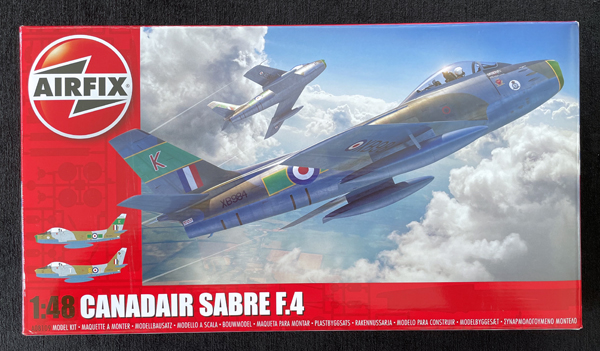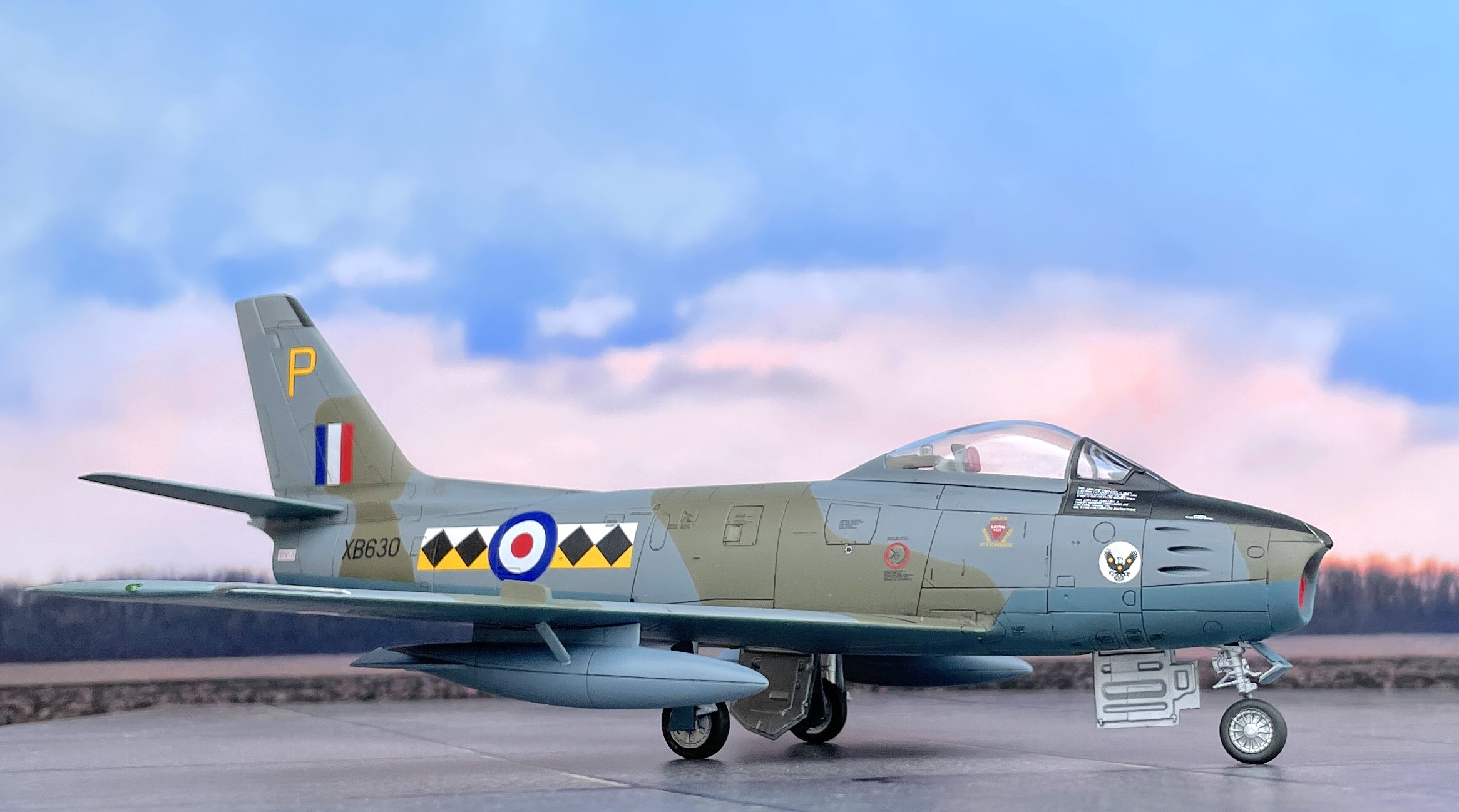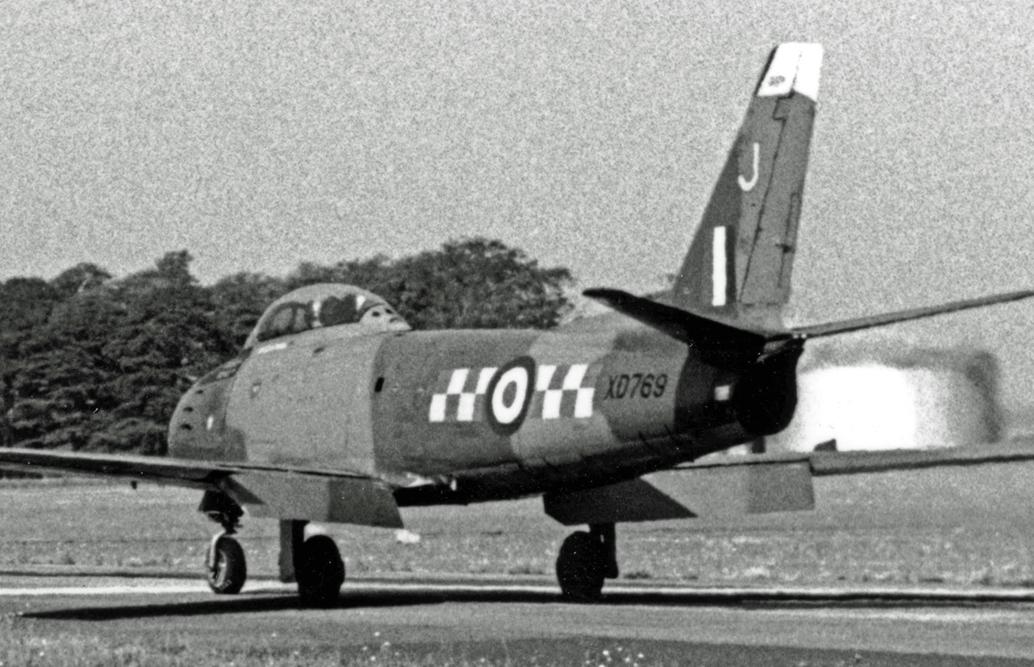
Full Review with Adam Waistell-Brown
In-box Here Now kit review
Introduction…
Airfix released the first incarnation of the Canadair Sabre back in 2010 and it was a gorgeous little kit. Spring forward to 2021 and they have released the F.4 in 1:48th. Let’s see what it’s like.
Just before we get into the build though, here’s a quick look at how it all turned out…

… and some info on the type…
The Canadair Sabre…
The Canadair Sabre is a jet fighter aircraft built by Canadair under licence from North American Aviation. A variant of the North American F-86 Sabre, it was produced until 1958 and used primarily by the Royal Canadian Air Force (RCAF) until replaced with the Canadair CF-104 in 1962. Several other air forces also operated the aircraft.
There were two major production runs of the aircraft. The first, the Mk. 2 and Mk. 4’s with just under 1,000 built, were very similar to their US counterparts, differing only in minor details. The second run, the Mk. 5’s and Mk. 6’s of similar numbers, were patterned on the later versions of the US Sabre with larger wings for improved manoeuvrability while replacing the original General Electric J47 engine with the locally-designed more-powerful Avro Canada Orenda. The Mk. 6, with a more powerful version of the Orenda, is widely considered the best of all Sabres.
The last of the Canadair Sabres in front-line operation were in Pakistan, whose AIM-9 Sidewinder equipped Mk. 6 models were the backbone of their air force during the Indo-Pakistani War of 1971. These racked up an impressive victory ratio over their Indian counterparts, which lacked missiles. These were slowly phased out after 1971, with the last examples leaving combat service in 1980. Although replaced by higher-performance designs in most other forces by the 1960s, late-model versions served in secondary roles into the 1970s.
Some Orenda-powered examples became famous for other feats. Most notable was the single Mk. 3, the test-bed for the Orenda fit, which Jacqueline Cochran used in 1953 to set several speed records, including becoming the first woman to break the sound barrier. Another, an ex-RCAF Mk. 6 that left service in 1974, went on to become Boeing’s chase plane for test flights until 1991. Many of these later aircraft are now preserved in museums.In 1948, the Canadian government decided to re-equip the RCAF with the F-86 Sabre with Canadair contracted to produce them in Montreal, Quebec, Canada. An initial batch of 10 aircraft was ordered for tool verification. The Korean War changed this to a production batch of 100 aircraft. Canadair slowly built up its production facility to make all components with related equipment obtained from other Canadian suppliers. Canadair gave the Sabre the project number CL-13.

Canadair produced six versions of the CL-13 Sabre. The sole Sabre Mk.1 was essentially the same as the North American Sabre F-86A. It had a General Electric J47-GE-13 turbojet of 5,200 lbf (23 kN) thrust. The Sabre Mk.2 had the same engine, although after the first 20 aircraft were produced, the remainder of the production run was distinguished in having power-assisted controls and an “all-flying” tailplane. The sole Sabre Mk 3 was the first of the Canadian Sabres to use the Avro Canada Orenda turbojet (Orenda 3 with 6,000 lbf (27 kN) thrust). The Sabre Mk.4 retained the General Electric engine and was destined for the RAF and was later passed on to other overseas air forces. The Sabre Mk.5 was the next production version, equipped with an Orenda 10 with 6,500 lbf (29 kN) thrust. A change to the Orenda 14 with 7,440 lbf (33 kN) powered the Sabre Mk.6.
The last Sabre to be manufactured by Canadair (Sabre #1815), after being donated by the Pakistan Air Force, is now part of the permanent collection in the Western Canada Aviation Museum (WCAM) in Winnipeg, Manitoba. From 1950 to 1958, a total of 1,815 CL-13 Sabres were built at the Canadair plant in Montreal. (Source: Wikipedia)